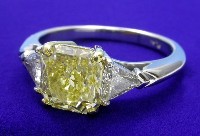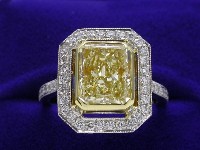Yellow is one of the most familiar names known to a large segment of general public besides white “colorless” diamonds. Canary is another name widely used in place of intense yellow diamonds.

The GIA’s D to Z color grading system applies to colorless to light yellow diamonds related to the relative absence of color. For colored diamonds, the presence of color establishes the color grade. Diamonds that have a tone and saturation greater than Z are Fancy color grades. The word Fancy is critical because that means the level of color is to the extreme right of the color scale rather than in the middle.
 Terminology is very important when it comes to describing color. In the Fancy Yellow color range; there are four color-grades (Fancy Light Yellow, Fancy Yellow, Fancy Intense Yellow and Fancy Vivid Yellow) with increasing prices with the higher intensity colors. Some of the yellows with higher intensity of color (Fancy Vivid Yellows) are as rare as the pinks and blues and command unusually high prices.
Terminology is very important when it comes to describing color. In the Fancy Yellow color range; there are four color-grades (Fancy Light Yellow, Fancy Yellow, Fancy Intense Yellow and Fancy Vivid Yellow) with increasing prices with the higher intensity colors. Some of the yellows with higher intensity of color (Fancy Vivid Yellows) are as rare as the pinks and blues and command unusually high prices.
Although faint yellow in white diamonds is not desirable, fancy intense yellow is sought after. Although India produced some yellows in the 16th and 17th centuries, South Africa today is the main producer of these gems. As a matter of fact, the first authenticated diamond found in South Africa was the 10.73 yellow Eureka. By 1900, South Africa had produced the 130 carat Colenso, the 228.50 DeBeers,and the 205.07 Red Cross. In 1996 at Christie’s, a 8.45 fancy vivid yellow sold for $684,500 or $81,000 per carat.
 Today, you can buy yellows in various shades from lemon yellow to taxicab yellow. The best pure yellow or orangish yellow will be called “fancy intense” or “fancy vivid” yellow on the Gemological Institute of America (GIA) grading report. These diamonds are rare and expensive. Slightly below these stones are the fancy yellows. These stones are more affordable but still quite yellow.
Today, you can buy yellows in various shades from lemon yellow to taxicab yellow. The best pure yellow or orangish yellow will be called “fancy intense” or “fancy vivid” yellow on the Gemological Institute of America (GIA) grading report. These diamonds are rare and expensive. Slightly below these stones are the fancy yellows. These stones are more affordable but still quite yellow.
Common names for yellow diamonds include canary, cape, daffodil, lemon, autumn, golden, manila, chartreuse, saffron etc.
 The yellow diamond rough is mined in South Africa, Brazil, Russia and India.
The yellow diamond rough is mined in South Africa, Brazil, Russia and India.
 Nitrogen in abundance is a major cause of yellow in diamonds. It occurs in higher concentration than any other element.
Nitrogen in abundance is a major cause of yellow in diamonds. It occurs in higher concentration than any other element.
The secondary hues and color modifiers for yellow diamonds include orange, green, brown, gray and olive.
The color of enhanced yellow diamonds closely resembles the natural yellow and is not easy to detect by eye. They need to be analyzed using infrared spectroscope.
The only way you can know with confidence what color you have with a colored diamond is to have the GIA Colored Diamond Grading Report. The independent GIA Laboratory has strict standards for grading colored diamonds where trained graders work in a controlled lighting environment and use an elaborate set of color comparisons to determine the hue, tone and saturation characteristics of colored diamonds.
Be wary of retailers selling colored diamonds without the GIA Colored Diamond Grading Report because you might discover that color grades are not as advertised and with colored diamonds, color is king in determining value. An exaggeration of a few color grades, especially if the actual color is below the Fancy color range, can result is significant differences in the value of the colored diamond.
 To enhance the appearance of Fancy yellow colors, the diamonds are typically set in yellow gold prongs and sometimes have a complete yellow gold tray under the diamond to enhance and even exaggerate the yellow color. While this makes good sense when displaying your colored diamond, it can be a challenge in determining the color of a diamond set in the mounting. It is best if colored diamonds are graded, examined and purchased based on their color loose. If you purchase a colored diamond already set in a mounting, the GIA Colored Diamond Grading Report becomes essential in ensuring you are purchasing the quality of diamond you desire.
To enhance the appearance of Fancy yellow colors, the diamonds are typically set in yellow gold prongs and sometimes have a complete yellow gold tray under the diamond to enhance and even exaggerate the yellow color. While this makes good sense when displaying your colored diamond, it can be a challenge in determining the color of a diamond set in the mounting. It is best if colored diamonds are graded, examined and purchased based on their color loose. If you purchase a colored diamond already set in a mounting, the GIA Colored Diamond Grading Report becomes essential in ensuring you are purchasing the quality of diamond you desire.

